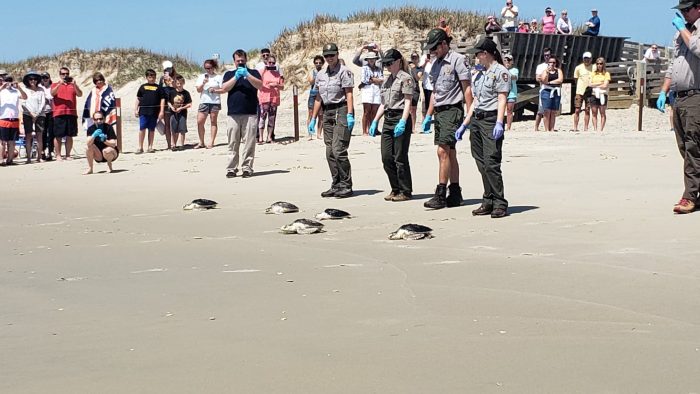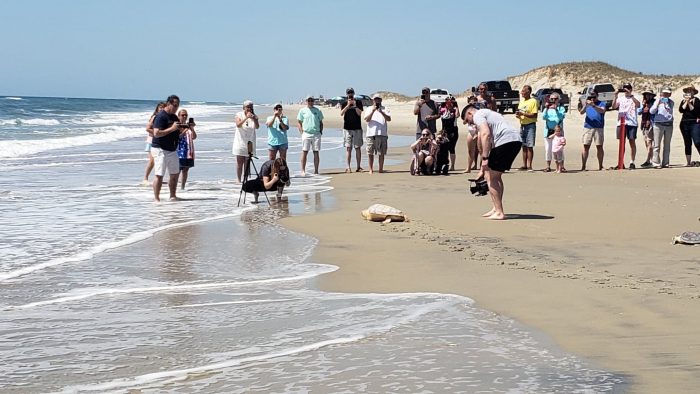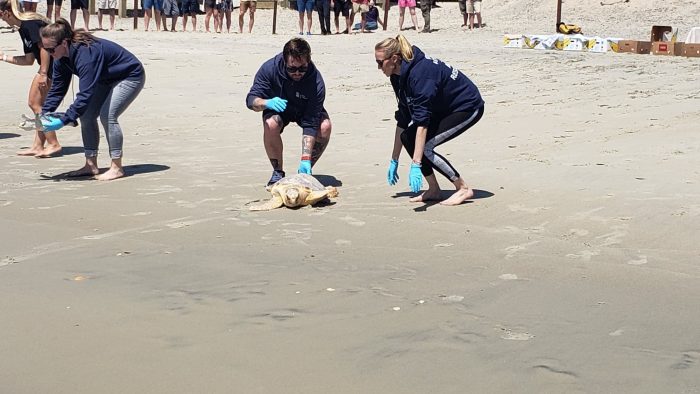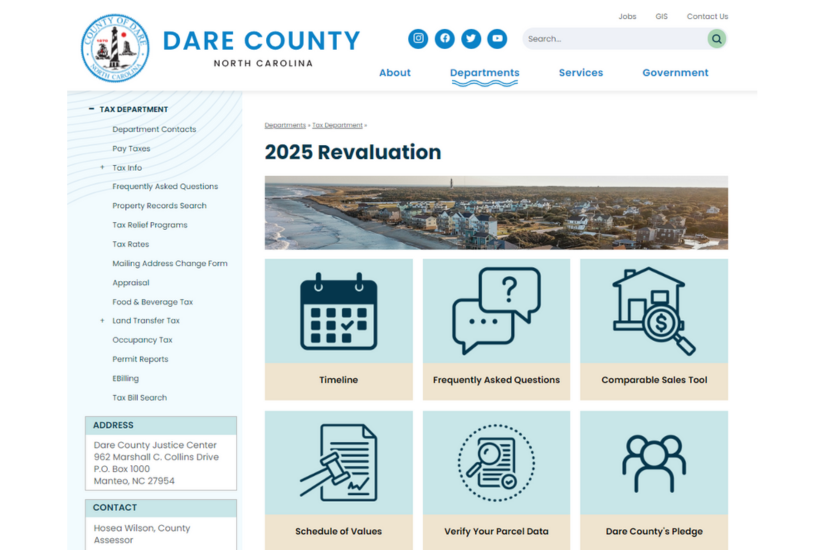26 sea turtles are released into the ocean in a first-ever collaboration with New England rescue organizations
26 cold-stunned sea turtles were released back into the Atlantic Ocean on Monday, April 25, in the biggest sea turtle release of the year on Hatteras Island, and the first-ever release involving sea turtle rescue organizations from well north of the Outer Banks.
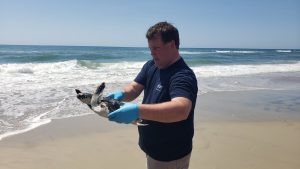
The 25 smaller Kemp’s ridley turtles and lone loggerhead turtle hailed from aquariums and rescue organizations in the Northeast, as representatives from the New England Aquarium in Boston, Mystic Aquarium in Connecticut, and the New York Marine Rescue Center shuttled the turtles down to Hatteras Island on a roughly 14-hour overnight drive.
“This is the first time we’ve ever physically been here,” said Adam Kennedy, New England Aquarium Rescue and Rehabilitation Manager. “In years past, we’ve typically gone down to either Florida or Georgia, but the water is warm enough for a release [in North Carolina] right now, and it’s better for the turtles to get here quicker instead of adding another 10 to 12 hours to their trip.”
As cold-blooded reptiles, sea turtles derive heat from their surroundings, and when they become too cold, their metabolism slows, prohibiting them from moving and migrating to warmer waters. This cold-stunned scenario can turn deadly, as once in an immobile and lethargic state, the sea turtles can have difficulty raising their heads above water to breathe.
Local volunteers regularly monitor the Hatteras Island shorelines after a cold spell, looking for cold-stunned sea turtles in need of assistance, and this process is mirrored in other parts of the East Coast where cold-stunned turtles are an issue, particularly in the New England area.
“There are only two places that this [phenomenon] happens regularly: here, and where these guys are coming from, which is Cape Cod,” said long-time Network for Endangered Sea Turtles (NEST) Hatteras Island Coordinator, Frank Welles. “Locally, this has been a slow year for cold-stunned sea turtles. Our sea turtle rescues were in the 50s this past winter, and a couple of years ago, that number was well over 200.”
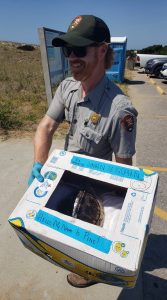
Up north, however, Kennedy reported that the New England Aquarium had 505 live strandings that came through their facility this past winter season. The turtles that were released on Monday in Hatteras village had recovered from being cold-stunned, were all healthy, and were all ready to be returned to the ocean.
“They’ve been off their medications for at least a month now, and they’re doing all the ‘normal’ things that we would see with turtles in the holding tanks,” said Kennedy. “They are eating well, and acting like they want to go back to the wild, and now it’s warm enough here to release them.”
Sea turtles typically need to be released in water temperatures that are 55-60 degrees or higher, which doesn’t occur in New England until much later in the year.
The reason why these New England turtles needed to be released sooner rather than later is twofold. For one thing, the northeast facilities have limited capacity for sea turtle rescues. For another, the longer the sea turtles are in captivity, the more they start to develop unusual behavior, such as becoming aggressive with each other.
Traditionally, the Cape Hatteras National Seashore (CHNS) partners with the local STAR Center at the Roanoke Island Aquarium to conduct sea turtle releases, and two of these events were held earlier in the year, with less than a dozen turtles at each release.
But in recent years, aquariums and recuse centers well north of the Outer Banks have been reaching out to CHNS representatives to collaborate on release events with turtles that originate miles away from home. “The word has spread that we’re the closest place [these organizations] can get to where the water’s warm enough, and we’ll likely have more of these partnerships in the future,” said CHNS’ lead biological science technician, William Thompson.
The New England team’s trip from their Quincey, Massachusetts headquarters started at 8:30 p.m. on Sunday night, and included two stops: one at the Mystic Aquarium in Connecticut to pick up some more turtle and human passengers, and one at the Vince Lombardi rest stop on the New Jersey Turnpike to meet up with the New York Marine Rescue Center.
Most of the turtles made the ensuing trek in their own personal Chiquita Banana cardboard box, lined with a towel or two, while the loggerhead turtle had to be housed within a large plastic bin, due to its size. “There were a couple of turtles that were a little squirmy on the drive, but they were mostly pretty quiet,” said Kennedy.
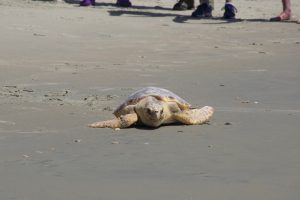
The rescuers and their turtle passengers arrived in Hatteras village on Monday morning at 11:00 a.m., where they promptly headed to the beach near ORV Ramp 55 to conduct the release.
The event was not publicized, but beachgoers who happened to be on the shoreline were treated to a remarkable show, as a small section of the beach was portioned off, and the turtles were released in small groups of 3-6.
“We were saying earlier this week that the one thing we’ve never done on an Outer Banks vacation was to see a sea turtle release,” said a longtime vacationer from Ohio. “So we can’t believe how lucky we are. This is a bucket list moment.”
All of the sea turtles made a successful trek back to the ocean – some slowly, and some at a rapid-fire pace – as onlookers took photos and videos of the procession.
It took just minutes for all 26 sea turtles to paddle out of sight into the open ocean, but with sea turtle nests and hatchings occurring in record numbers on the Outer Banks, there is a solid chance that these New England-based visitors may return to Hatteras and Ocracoke Islands someday.
Sea turtles spend most of their time in the ocean, but they return to land to nest before disappearing back into the water. And in the past few years, the number of nesting sea turtles along the Cape Hatteras National Seashore has been booming.
“Nesting season is about to begin, and we start patrolling the beaches around May 1,” said Thompson. “I think back to the 11 years I’ve been here, and the numbers have only gone up on average, so I think we’re going to have another busy year for sea turtles.”
